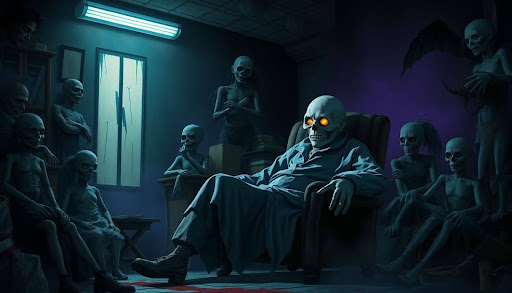The Last House on Needless Street by Catriona Ward – A Haunting Book Review
Step into the chilling world of “The Last House on Needless Street” by Catriona Ward, a book that’s captured the attention of thriller and horror enthusiasts. With its twisted narrative style and an ambiance dripping with suspense, this novel pushes the boundaries of storytelling. Readers are drawn into a labyrinth of perspectives, where every character holds a part of the mystery. From Ted’s uneasy existence to the lurking shadows of a missing child’s secret, this book keeps you guessing until the very end. As Ward takes you through a haunting journey filled with psychological depth, prepare to question everything you think you know about psychological thrillers.
Overview of “The Last House on Needless Street”
“The Last House on Needless Street” by Catriona Ward invites readers to immerse themselves in a world where perception and reality blur. This gripping tale intertwines the lives of Ted, his daughter Lauren, Olivia the cat, and Dee, each holding pivotal pieces to the unfolding mystery. The unique narrative unfolds through non-linear storytelling and multiple perspectives, enhancing its psychological depth. This storytelling choice keeps readers on their toes, piecing together the puzzle with each character’s viewpoint.
A Mysterious Narrative
In “The Last House on Needless Street”, the narrative structure crafts an enigmatic tapestry. We experience the world through the voices of Ted, Lauren, and Olivia the cat, offering a surreal insight into their lives. This approach injects a persistent sense of ambiguity and suspense, as readers must decipher truth from illusion. These diverse perspectives challenge our understanding of reality, encouraging us to question everything. Each character’s narrative adds another layer to the mystery, building tension until the final revelation. For a deeper exploration of how these elements are woven together, invest some time in this detailed analysis.
Setting and Atmosphere
The house at the heart of Ward’s novel is more than just a setting; it’s a character itself. Nestled at the end of a dead-end street and surrounded by dark woods, it embodies isolation and eerie charm. The house’s oppressive atmosphere complements the theme of entrapment and secrecy, creating a haunting backdrop that stays with you long after the last page. The story’s environment enhances the psychological tension, wrapping readers in a cloak of suspense as the characters’ secrets unfold. Explore further insights into this sinister setting with this in-depth book review.
This book not only plays with your mind but also your senses, as the eerie atmosphere adds a chilling dimension to the already intense narrative. Whether you’re a seasoned thriller fan or new to the genre, this novel’s mysterious allure promises an unforgettable reading experience.
Themes Explored in the Novel
“The Last House on Needless Street” by Catriona Ward is not just a thriller; it’s a nuanced exploration of deeper human experiences. Through its complex characters and narrative style, the novel explores profound themes that resonate with readers. Below, we dive into the critical themes of trauma, isolation, and unreliable narration that Ward intricately weaves into her story.
Trauma and Its Effects
The novel delves into the profound impact of psychological trauma on its characters, shaping their actions and interactions. Trauma is not a straightforward element in the narrative; it’s a hidden force that influences decisions and alters perceptions. Ted, one of the central characters, embodies the weight of past trauma, which manifests in his erratic behaviors and fractured views of reality. The echo of past experiences reverberates through the storyline, illustrating how trauma can distort one’s understanding and even reshape identity. For a deeper understanding of trauma’s role in literature, visit Trauma Studies – Literary Theory and Criticism.
Isolation and Disconnection
Isolation is a powerful theme in Ward’s novel, underscoring the characters’ emotional and physical detachment from the world. The house itself is a symbol of seclusion, with its remote location amplifying the sense of disconnect experienced by the characters. Ted’s interactions are limited, creating an echo chamber that reinforces his own distorted beliefs and fears. This theme of isolation explores the psychological toll of being cut off from reality and others, a common motif in literature as seen here. The novel’s setting magnifies these feelings, making the reader question how environment influences one’s mental state.
Exploration of Unreliable Narration
Ward cleverly employs unreliable narrators to maintain suspense and challenge the reader’s understanding of truth. Each narrator presents their version of events, leaving the reader to decipher fact from fiction. This technique not only keeps the tension high but also invites readers to question their assumptions and biases. An unreliable narrator becomes a puzzle, with pieces revealed as the story progresses, requiring readers to pay close attention to nuances that could alter their perception of the narrative. To explore this narrative device further, check out What is an Unreliable Narrator?.
By dissecting these themes, Catriona Ward crafts a novel that is as much about the human psyche as it is about external suspense. These thematic explorations add layers to an already gripping tale, leaving readers contemplating long after they have turned the final page.
Key Strengths of the Book
Catriona Ward’s “The Last House on Needless Street” stands out as a thought-provoking thriller through its arresting narrative structure and compelling character portrayals. Each component of Ward’s story contributes to the novel’s unique identity, making it a captivating read for thriller and horror enthusiasts alike.
Innovative Storytelling
One of the novel’s key strengths is its innovative storytelling. Ward utilizes a non-linear narrative that invites readers to piece together a puzzle of carefully layered mysteries. This style keeps you on your toes as you navigate through seemingly disjointed timelines and perspectives. The story weaves between the voices of Ted, Lauren, and Olivia the cat, each offering their own lens on the unfolding drama. This complexity engages readers by challenging them to discern reality from illusion, creating a tapestry of suspense and intrigue. You can explore more about this narrative approach in this detailed review.
Multifaceted Characters
The depth of Ward’s characters adds another layer of fascination to the novel. Each character is given intricate layers, making them both compelling and, at times, unsettling. Ted is portrayed not as a clear-cut protagonist or antagonist, but as a blend of shadow and light, inviting readers to explore the moral ambiguities of his being. This characteristic complexity is mirrored in the other characters, such as Olivia, whose perspective adds freshness to the narrative. Ward peels back layers of their personalities slowly, constructing a rich and often disturbing portrait that lingers long after the last page. For a detailed character analysis, visit this insightful discussion.
Dark and Immersive Atmosphere
Ward’s writing style excels at crafting a dark and immersive atmosphere that envelops the reader in unease. The setting, a looming house at the end of a reclusive street, serves as more than just a backdrop; it becomes a player in the narrative. The prose is exceptional, with a style that maintains a balance between rich detail and accessibility, drawing readers into a world where every shadow holds a secret. This atmospheric tension is integral to the book’s appeal, amplifying the suspense and emotional impact. For an exploration of this atmosphere, check out this review of the novel.
By weaving these elements together, Ward has created a novel that commands the reader’s attention and curiosity, making “The Last House on Needless Street” a standout entry in the psychological thriller genre.
Challenges Some Readers May Face
Reading “The Last House on Needless Street” by Catriona Ward presents its own set of challenges. The novel’s intricate and unconventional storytelling style can mystify even the most seasoned readers. Here, we will explore how the narrative’s complexity might initially confuse but ultimately reward those who persevere.
Understanding the Plot
At first glance, the plot of “The Last House on Needless Street” can appear like a tangled web, intricately woven and full of surprises. The book’s non-linear narrative and multiple points of view create a maze-like experience.
- Complex Narration: The story unfolds through the eyes of various characters—each with their own interpretation of events. This method can leave readers piecing together fragments, akin to assembling a jigsaw puzzle without looking at the box cover. The fragmented narrative echoes the thought-provoking nature of the book.
- Unreliable Narrators: Each character brings their subjective reality to the table, challenging readers to distinguish fact from fiction. Ted, in particular, serves as an unreliable storyteller, making the truth elusive. You may find yourself questioning who to trust, which adds layers to the reading experience. This aspect can be confounding yet fascinating when you look closer at the novel’s core themes.
For readers who embrace the complexity, understanding begins to dawn as the narrative threads converge. There is a certain satisfaction in decoding the layered story that Ward offers. It’s a reminder that sometimes, the journey itself holds the greatest reward.
Comparison to Similar Works
Comparing “The Last House on Needless Street” to other books in the psychological horror genre highlights its unique qualities while acknowledging the inspirations that have shaped its narrative.
Influences and Inspirations
Ward’s novel draws on the traditions of psychological horror, a genre known for exploring the dark corners of the human psyche. Influences can be traced back to classics like The Haunting of Hill House by Shirley Jackson and modern thrillers such as Gone Girl by Gillian Flynn. These works share a common thread of psychological tension and unreliable narration, elements that Ward skillfully incorporates. Ward’s ability to weave mental and emotional distress into the narrative places her work firmly within the psychological horror canon, yet she adds her own fresh take.
The richness of the psychological horror genre is further explored in insights on how horror movies manipulate our minds, showing the genre’s multifaceted roots and inspirations. Ward’s novel embodies these elements, yet distinctively focuses more on the internal chaos of its characters rather than external frights.
Unique Features
What sets “The Last House on Needless Street” apart from other psychological thrillers and horror novels is its intricate narrative structure and innovative storytelling techniques. While many books in the genre lean on jump scares or supernatural elements, Ward’s novel dives deep into the human psyche, offering a grounded yet unsettling experience. Unlike typical horror novels, it avoids graphic violence, instead relying on a sense of dread and a rich atmosphere to captivate readers. This approach is detailed in Storyville’s analysis of writing psychological horror.
The mix of realism and psychological elements is a key characteristic that distinguishes it from other works like Silent Hill or even psychological thrillers mentioned in this guide. Ward crafts a suspenseful and thought-provoking narrative by focusing on character depth and moral ambiguity, making it a standout novel that stays with readers long after the last page is turned.
Why Readers Will Love It
Catriona Ward’s “The Last House on Needless Street” is a gripping read that promises to captivate your imagination from start to finish. Whether you are a seasoned psychological thriller reader or just dipping your toes into the genre, this novel offers something unique and unforgettable.
Engaging Twists and Turns
One of the standout features of “The Last House on Needless Street” is its brilliantly unpredictable plot. Just when you think you’ve grasped the storyline, Ward throws another curveball that leaves you questioning everything you know. The plot is riddled with mind-bending twists that ensure you stay on the edge of your seat.
- Constant Suspense: The storyline is woven with layers of mystery and suspense, making each chapter more thrilling than the last. A feeling of perpetual dread lingers throughout, similar to stepping barefoot on an unexpected worm (NPR Review).
- Mystery Unraveled Slowly: Each twist is carefully crafted to slowly unravel the deeper mysteries at play. This keeps the momentum going while ensuring readers remain engaged and continuously guessing. The shifts in perspective contribute significantly to its unpredictable nature, as explored further here.
Emotional and Thought-Provoking
This novel doesn’t just entertain; it challenges you to think deeply about its multifaceted themes and characters. Ward masterfully intertwines the emotional with the philosophical, crafting a narrative that evokes strong feelings.
- Intense Characterization: The emotional depth of each character invites readers to explore complex themes like trauma and identity. They are not just players in a story but gateways to profound ideas. For instance, Ted’s psychological journey is as gripping as the plot itself, making readers question motives and emotions (Vogue Horror).
- Reflective Themes: More than just a thriller, this book reflects on the darkest aspects of human nature, compelling readers to ponder on what drives people to do the unthinkable. These thoughts resonate long after the story concludes, leaving a lasting impression.
In “The Last House on Needless Street”, Catriona Ward offers a narrative that is both exhilarating and reflective, securing its place as a must-read for fans of the genre. As Stephen King himself noted, the layers of secrets and revelations push the boundaries of what a psychological thriller can achieve. Prepare to be enthralled, challenged, and ultimately satisfied by this impeccable story.
Conclusion
“The Last House on Needless Street” by Catriona Ward is a mesmerizing journey for those who enjoy unraveling complex psychological tales. Its unique storytelling approach, blending unreliable narrators with a tense and eerie atmosphere, hooks you from the start. The book artfully challenges perceptions and pushes the boundaries of the thriller genre.
Ward’s novel is particularly suited for readers who relish dark mysteries and are comfortable navigating intricate plots. As you piece together the layers of secrets and explore the depths of trauma and identity, the experience is both rewarding and thought-provoking.
If you enjoy a story that keeps you guessing and makes you think deeply about its themes, this novel is a must-read. Dive in for an unforgettable experience and share your thoughts with fellow book lovers.







